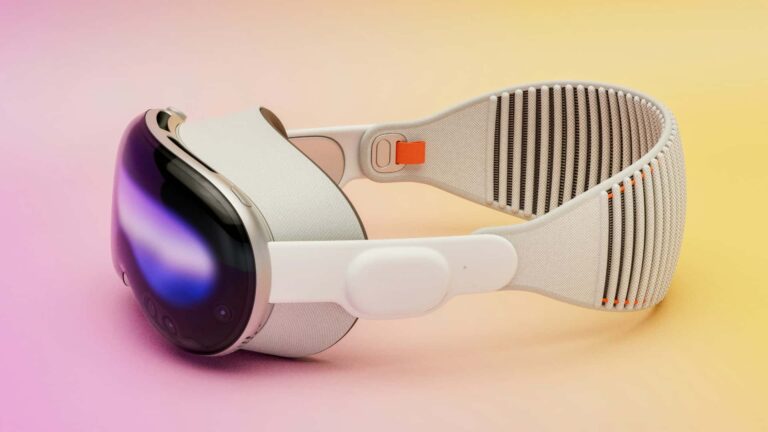
Though Apple Vision Pro’s polished marketing emphasizes consumer use cases – mostly immersive entertainment through massive virtual screens – practical adoption in early days is enterprise-weighted. You could mostly guess that by AVP’s $3,500 price tag.
As we noted in our early analysis, this enterprise adoption includes developers. AVP is partly an expensive dev kit for those who want to start building muscles around the design language and native UX that will shine on the device. TikTok is one early example of how this is done.
In fact, this is what Apple wants. Though consumer-targeted marketing is sexier, it wants developers to gain native footing. The company knows that a scaled and crowdsourced developer ecosystem will engender all the apps that help sell Vision Pro. We’ve seen this movie before.
Beyond developers, the other enterprise use cases involve productivity and design collaboration. These are the very use cases that the broader AR and VR worlds have used as lifeboats as they wait for consumer markets to show up. Enterprises are less cost- and style-sensitive.
AVP at Work
Apple’s recent press release validates some of the above by spotlighting productivity use cases already landing. They include everything from collaboration to productivity via floating virtual monitors and immersive training. Here’s Apple’s full list, reworded and de-jargoned for brevity…
Customized Workspaces for Productivity
SAP Analytics Cloud helps streamline the process of gathering, integrating, analyzing, and presenting data-driven insights to enhance business decision-making. On Apple Vision Pro, the app enables employees and executives to access their data dashboard and arrange business workflows, apps, and cards in their space. They can also drill down into the data with contextual 3D maps and graphics.
Microsoft 365 productivity apps (including Copilot AI assistance) on Vision Pro are meant to help users get more done. This includes a “focus mode” in Word, immersive data and slideshows in Excel and PowerPoint; and fast switching between meetings, chats, and shared content in Teams.
Webex by Cisco offers meetings that fill the space around the user and tap into AVP’s native Personas and Spatial Audio to make the experience feel more natural.
Zoom also has a native Vision Pro experience that likewise taps into immersive audio and video.
Box’s Vision Pro app brings file management into a 3D environment, which is useful for things like 3D product models and remote design collaboration.
Design and Collaboration
The Porsche Race Engineer app helps Porsche race engineers collaborate on real-time decisions such as car performance, track conditions, and driver vitals.
NVIDIA Omniverse Cloud APIs let developers stream large 3D engineering and simulation data sets from the cloud to Apple Vision Pro. The high-resolution displays enable detailed and immersive renderings that can be viewed and/or manipulated in real time.
Lowe’s Style Studio lets in-store customers work with kitchen design consultants to visualize and design their new kitchen.
JigSpace’s Vision Pro experience lets users share and examine 3D models together, which has applicability in product design, engineering, and education.
EnBW (Energie Baden-Württemberg AG) uses Vision Pro to visualize renewable energy infrastructure projects including vehicle charging stations, wind turbines, and solar farms.
Training and Simulation
KLM Royal Dutch Airlines uses Vision Pro to improve technical maintenance and airline operations. The Engine Shop app lets technicians train in simulated environments. This immersive learning reduces errors through greater spatial understanding while saving time and speeding up plane turnaround times.
Taqtile Manifest makes digital work instructions more dimensional and line-of-sight. It also makes them more interactive and actionable through AVP’s native inputs (glance or hand gesture).
PTC’s Onshape Vision app elevates the ways product designers and engineers can view, interact with, and collaborate on complex 3D models.
Guided Work
FireOps app, developed by About Objects and DigitalCM, uses AVPs infinite canvas for a unified operational view of incident action plans. This enhances coordination and decision-making.
TeamViewer Spatial Support enables remote experts and service technicians on the ground to troubleshoot repair and maintenance processes with greater interactivity and speed.
BILT supports 3D interactive instructions for things like product repair. This includes voice, text, and animated guidance.
De-Risking Devices
Back to Apple’s intentions, it sees an enterprise opportunity even though it has marketed Vision Pro’s main use cases as consumer-centric. One piece of evidence can be seen in Apple’s device management moves. It wants to take friction and risk out of the equation.
Specifically, as we recently examined, Apple will include Vision Pro in the existing enterprise device management program (think: AppleCare for enterprise). This lets businesses manage Vision Pro in the same workflows they currently use for iPhones, iPads, Macs, and wearables.
This includes things like support, repair, and easy employee onboarding. It can also remotely wipe devices in the case of loss or theft. Apple knows all of this will be required to get enterprises over the adoption hump, as it can ease uncertainty and de-risk an unproven technology.
In addition to device management and security, Apple is also keen on lowering development friction. That includes VisionOS itself, as well as APIs, Swift tutorials, the VisionOS simulator, and the new Enterprise Spatial Design Lab, which offers hands-on Apple support.
Either way, Vision Pro’s adoption path will be long and winding. Apple realizes that and is playing a long game. In fact, brand marketer adoption could be similar to past technologies in that we’ll see a rush of early adopters, then years of gradual traction from the long tail.

